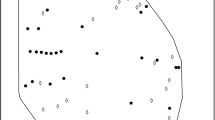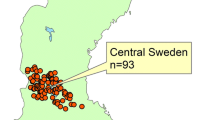Abstract
The importance of riparian vegetation to support stream function and provide riparian bird habitat in semiarid landscapes suggests that standardized assessment tools that include vegetation criteria to evaluate stream health could also be used to assess habitat conditions for riparian-dependent birds. We first evaluated the ability of two visual assessments of woody vegetation in the riparian zone (corridor width and height) to describe variation in the obligate riparian bird ensemble along 19 streams in eastern Oregon. Overall species richness and the abundances of three species all correlated significantly with both, but width was more important than height. We then examined the utility of the riparian zone criteria in three standardized and commonly used rapid visual riparian assessment protocols—the USDI BLM Proper Functioning Condition (PFC) assessment, the USDA NRCS Stream Visual Assessment Protocol (SVAP), and the U.S. EPA Habitat Assessment Field Data Sheet (HAFDS)—to assess potential riparian bird habitat. Based on the degree of correlation of bird species richness with assessment ratings, we found that PFC does not assess obligate riparian bird habitat condition, SVAP provides a coarse estimate, and HAFDS provides the best assessment. We recommend quantitative measures of woody vegetation for all assessments and that all protocols incorporate woody vegetation height. Given that rapid assessments may be the only source of information for thousands of kilometers of streams in the western United States, incorporating simple vegetation measurements is a critical step in evaluating the status of riparian bird habitat and provides a tool for tracking changes in vegetation condition resulting from management decisions.




Similar content being viewed by others
References
Altman B, Holmes A (2000) Conservation strategy for landbirds in the Columbia Plateau of eastern Oregon and Washington (version 1.0). Oregon/Washington Partners in Flight. Available at: http://www.orwapif.org/consplan.html
Anderson EM (2007) Changes in bird communities and willow habitats associated with fed elk. Wilson J Ornithol 119(3):400–409
Barbour MT, Gerritsen J, Snyder BD, Stribling JB (1999) Rapid bioassessment protocols for use in streams and wadeable rivers: periphyton, benthic macroinvertebrates and fish. 2nd edn. EPA 841-B-99-002. U.S. Environmental Protection Agency, Office of Water, Washington, DC
Belsky AJ, Matzke A, Uselman S (1999) Survey of livestock influences on stream and riparian ecosystems in the western United States. J Soil Water Conserv 54(1):419–431
Bjorkland R, Pringle CM, Newton B (2001) A stream visual assessment protocol (SVAP) for riparian landowners. Environ Monitor Assess 68:99–125
Burnham KP, Anderson DR (1998) Model selection and inference: a practical information—theoretic approach. Spring-Verlag, New York
Clary WP (1999) Stream channel and vegetation responses to late spring cattle grazing. J Range Manage 52:218–227
Cunningham RB, Lindenmayer DB (2005) Modeling count data of rare species: some statistical issues. Ecology 86(5):1135–1142
Davidson AS, Knight RL (2001) Avian nest success and community composition in a western riparian forest. J Wildl Manage 65:334–344
DeSante DF, George TL (1994) Population trends in the landbirds of western North America. Stud Avian Biol 15:173–190
Dobkin DS, Wilcox BA (1986) Analysis of natural forest fragments: riparian birds in the Toiyabe Mountains, Nevada. In: Verner J, Morrison ML, Ralph CJ (eds) Wildlife 2000: modeling habitat relationships of terrestrial vertebrates. University of Wisconsin Press, Madison
Elmore W (1998) Twenty-one years. The ever-changing tale of Oregon’s Bear Creek. Range Mag Spring:32–35
Fauth JE, Bernardo J, Camara M, Resetarits WJ Jr, Van Buskirk J, McCollum SA (1996) Simplifying the jargon of community ecology: a conceptual approach. Am Nat 147(2):282–286
Fleishman E, McDonal N, MacNally R, Murphy DD, Walters J, Floyd T (2003) Effects of floristics, physiognomy and non-native vegetation on riparian bird communities in a Mojave Desert watershed. J Anim Ecol 72:484–490
Guisan A, Zimmermann NE (2000) Predictive habitat distribution models in ecology. Ecol Model 135(2–3):147–186
Haefner JW (1996) Modeling biological systems: principles and applications. Chapman and Hall, New York
Hintze J (2001) NCSS and PASS. Number Cruncher Statistical Systems, Kaysville, UT
Hughes JM (1999) Yellow-billed cuckoo (Coccyzus americanus). In: Poole A, Gill F (eds) The birds of North America, No. 418. Birds of North America, Inc., Philadelphia
Kauffman JB, Krueger WC (1984) Livestock impacts on riparian ecosystems and streamside management implications… a review. J Range Manage 37(5):430–437
Knopf FL, Sedgwick JA (1992) An experimental study of nest-site selection by yellow warblers. Condor 94:734–742
Kovalchik BL, Elmore W (1992) Effects of cattle grazing systems on willow-dominated plant associations in central Oregon. In: Clary WP, McArthur ED, Bedunah D, Wambolt CL (eds) Proceedings—Symposium on Ecology and Management of Riparian Shrub Communities. General Technical Report INT-289. U.S. Forest Service
Krueper DJ (1993) Effects of land use practices on western riparian ecosystems. In: Finch DM, Stangel PW (eds) Status and management of neotropical migratory birds. General Technical Report RM-229. U.S. Forest Service
Larison B, Laymon SA, Williams PL, Smith TB (2001) Avian responses to restoration: nest-site selection and reproductive success in song sparrows. Auk 118(2):432–442
MathSoft, Inc. (2000) S-PLUS 2000 Professional Release 1. MathSoft, Needham, MA
Miller LH (1904) The birds of the John Day region, Oregon. Condor 6:100–106
Munné A, Prat N, Solà C, Bonada N, Rieradevall M (2003) A simple field method for assessing the ecological quality of riparian habitat in rivers and streams: QBR index. Aquat Conserv Mar Freshw Ecosyst 13:147–163
Obedzinski RA, Shaw CGIII, Neary DG (2001) Declining woody vegetation in riparian ecosystems of the western United States. West J Appl Forest 16(4):169–181
Powell BF, Steidl RJ (2002) Habitat selection by riparian songbirds breeding in southern Arizona. J Wildl Manage 66(4):1096–1103
Quinn GP, Keough MJ (2002) Experimental design and data analysis for biologists. Cambridge University Press, Cambridge
Ralph CJ, Geupel GR, Pyle P, Martin TE, DeSante DF (1993) Handbook of field methods for monitoring landbirds. General Technical Report PSW-GTR-144. U.S. Forest Service
Rich TD (2002) Using breeding land birds in the assessment of western riparian systems. Wildl Soc Bull 30(4):1128–1139
Rottenborn SC (1999) Predicting the impacts of urbanization on riparian bird communities. Biol Conserv 88:289–299
Sanders TA, Edge WD (1998) Breeding bird community composition in relation to riparian vegetation structure in the western United States. J Wildl Manage 62(2):461–473
Scott ML, Skagen SK, Merigliano MF (2003) Relating geomorphic change and grazing to avian communities in riparian forests. Conserv Biol 17(1):284–296
Sedgwick JA (2000) Willow flycatcher (Empidonax traillii). In: Poole A, Gill F (eds) The birds of North America, No. 533. Birds of North America, Inc., Philadelphia
Sharp B (1985) Avifaunal changes in central Oregon since 1899. West Birds 16:63–70
Taylor DM, Littlefield CD (1986) Willow flycatcher and yellow warbler response to cattle grazing. Am Birds 40(5):1169–1173
USDA NRCS (U.S. Department of Agriculture Natural Resources Conservation Service) (1998) Stream visual assessment protocol. NWCC-TN-99-1. National Water and Climate Center, Portland, OR
USDI BLM (U.S. Department of Interior Bureau of Land Management) (1995) Riparian area management: process for assessing proper functioning condition. Technical Reference 1737-9 1993, revised 1995. Bureau of Land Management, Washington, DC
USDI BLM (U.S. Department of Interior Bureau of Land Management) (2005) Public land statistics. Bureau of Land Management, Washington, DC
Van Horne B (1983) Density as a misleading indicator of habitat quality. J Wildl Manage 47:893–901
Ward TA, Tate KW, Atwill ER, Lile DF, Lancaster DL, McDougald N, Barry S, Ingram RS, George HA, Jensen W, Frost WE, Phillips R, Markegard GG, Larson S (2003a) A comparison of three visual assessments for riparian and stream health. J Soil Water Conserv 58(2):83–88
Ward TA, Tate KW, Atwill ER (2003b) Visual assessment of riparian health. Publication 8089. University of California Division of Agriculture and Natural Resource, Oakland, CA
Acknowledgments
This research was funded by the Bureau of Land Management, the Packard Foundation, the Natural Resources Conservation Service Wildlife Habitat Management Institute, and the Wildlife Conservation Society North America Program. In-kind, logistical, and financial support was also provided by the Bureau of Land Management Prineville District. Wayne Elmore and the National Riparian Service Team were instrumental in the development of this research and we benefited greatly from their expertise and experience. For guidance and/or comments on earlier versions of the manuscript we would like to thank K. Farris, T. L. George, J. Hilty, J. Liebezeit, C.L. Mahon, E. Richardson, W. D. Ritts, B. Sharp, and several anonymous reviewers. We thank D. Humple, V. Eurs, J. Hoffman, A. Holmes, K. O’Hearn, S. Quinlan, and A. Simard for assistance in data collection.
Author information
Authors and Affiliations
Corresponding author
Rights and permissions
About this article
Cite this article
Cooke, H.A., Zack, S. Use of Standardized Visual Assessments of Riparian and Stream Condition to Manage Riparian Bird Habitat in Eastern Oregon. Environmental Management 44, 173–184 (2009). https://doi.org/10.1007/s00267-008-9160-0
Received:
Revised:
Accepted:
Published:
Issue Date:
DOI: https://doi.org/10.1007/s00267-008-9160-0




